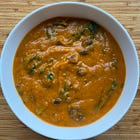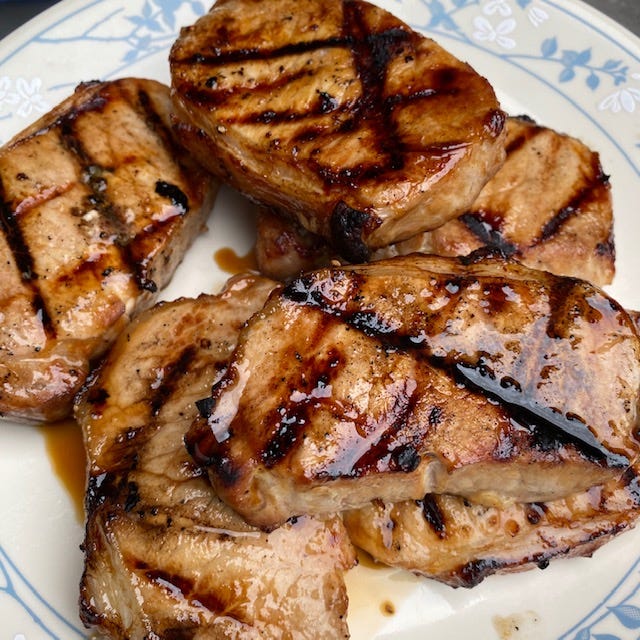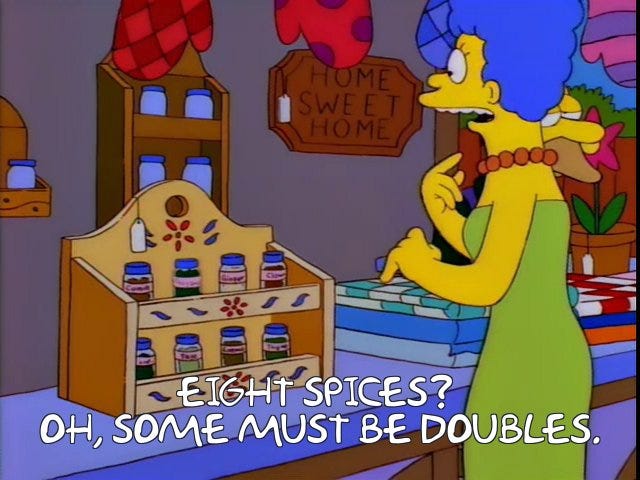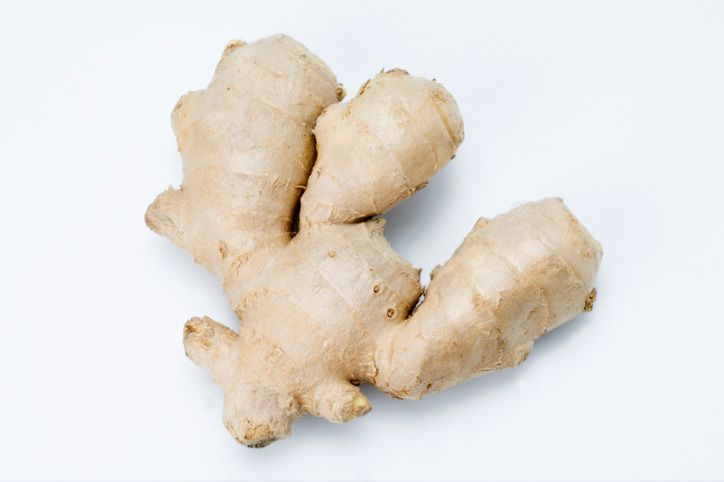Kitchen Lessons I Wish I'd Learned Sooner
Let's travel back in time and tell our 19-year-old selves about fresh ginger
I’m not an average cook.
This is not meant as a brag about my culinary abilities—I screw up dinner plenty, and I often share the results of those screw-ups here.
No, it’s a statement on my resources, interest and experience. I’m someone who loves to cook, someone who’s had to commandeer our front coat closet for kitchen devices that don’t fit in the kitchen proper. I’m the kind of cook who drags his family to a kitchen supply store in the middle of a trip to Paris because one of my similarly-obsessive-about-cooking friends went there and I got jealous.
I’m not a normal cook, is what I’m saying.
There was a time, though, where I couldn’t cook to save my damn life.
Twenty years ago, I was living in a shabby off-campus house near the University of Cincinnati, an apartment lined floor-to-ceiling with the ugliest wood paneling you’ve ever seen that harbored an influx of crickets each fall. At the time, my culinary abilities were largely limited to cooking extremely-dry chicken breasts on a George Foreman Grill, dumping them into a bowl of unseasoned couscous with some shredded cheese, and then dousing the whole thing in Frank’s Red Hot. This was the height of cooking to an idiot twenty-year-old, and in the darkest corners of my mind, it still is.
I grew up, though, and I eventually learned to cook, bit by agonizing bit. I got a couple more pots, and a couple more knives. I watched a lot of Food Network—Emeril Lagasse and Alton Brown and Rachael Ray—and I learned to mimic their recipes. I bought some cookbooks, and eventually I learned to cook without them.
All of this, of course, would eventually culminate in me making football-shaped arancini filled with Cincinnati chili.
(See? I told you I’m not bragging.)
People often fantasize about what they’d do if—through some miracle of time travel, or maybe the mailbox from The Lake House (2006)—they got the chance to talk to their younger self, impart the hard-earned wisdom they have now and wished they’d had back then. You’d tell your younger self a lot of things—not to date that one person, not to ignore those red flags in a job interview, not to eat that gas station sushi or become a Cleveland Browns fan.
I’d want to tell myself all those things, too—but if I had time, I’d also give that dumb kid some cooking tips earlier. Sure, he wouldn’t have access to a pressure cooker or a sous-vide circulator or a drawer that doesn’t close because of all the kitchen tools stuffed in it. Even with just a couple dull knives, a cheap non-stick pan and a secondhand pot, a limited spice cabinet and a landlord-special oven that may or may not heat evenly or accurately, though, he could still cook something a lot better than that George Foreman chicken.
With that in mind, here’s a few lessons I wish I’d learned sooner.
Use the pasta water
We all know this one now, right? I sure as hell didn’t know it for the longest time, and as someone who ate a lot of spaghetti, it sure would’ve helped. Instead, I’d pour cold sauce over hot, fully-drained noodles and just hope for the best.
Cacio e pepe’s become a buzzy culinary concept in recent years, but really, it doesn’t take much other than some starchy cooking water, a little bit of good cheese and some cracked black pepper to make a pasta that would’ve been worlds better than lukewarm, watery Ragu. Virtually every pasta I make now—even if it is just adding a jar of store-bought marinara to noodles—benefits from adding the sauce in the pan along with a splash of the pasta water.
Get the spices in early
Some of the first dishes where I started to feel like I was getting a hang of cooking were one-pot meals—soups, curries, chili. A one-pot meal is a great way to build a sense of accomplishment in the kitchen, and it just makes sense when, in fact, you only have one pot. I’ve written before about how one of my earliest culinary wins came from making a pumpkin-and-black-bean soup from 30-Minute Meals, something that eventually inspired this fancier-but-still-simple soup I shared last year:
Whether it’s that, a chili, or any other one-pot meal, though, it took me far too long to realize I needed to put the spices in at the beginning, not stirring them in at the end. Letting them bloom in the hot cooking oil early in the process brings out so much more flavor, and spreads that flavor much more evenly through the dish.
A marinade doesn’t need much, it just needs time
To a younger me, marinades were intimidating, inscrutable potions, things I’d buy by the bottle at Kroger and dump on my chicken breast tenderloins mere moments before burning them on the George Foreman.
(Seriously, I used that thing a lot. It’s not a bad device by any means, but I was torturing food on it.)
It turns out? It hardly takes anything for a good marinade other than time.
During the grilling months (April through March), one of my favorite easy weeknight dinners is to dump a package of pork chops or chicken thighs into a dish, throw in a half-dozen cloves of chopped garlic, a half-cup of soy sauce and a 12-ounce bottle of fruit-flavored cane sugar soda (like Jarritos Pineapple), and let it sit. A full day is great, but before-work to after-work is plenty, too. It’s enough to get rich, juicy, flavorful meat for an added ingredient cost of about $1.25.
Try one fresh spice. One!
Thinking back on that college apartment, my “spice cabinet”, as it were, would look something like this:
garlic powder
chili powder
McCormick Montreal Steak Seasoning
The idea of using a fresh spice? Unfathomable! I was basically Marge Simpson considering a spice rack:
In time, I’d learn to swap the garlic powder out for fresh, though not without a lengthy interim of buying the jarred, pre-minced stuff.
Fresh ginger, though?
I’m a bit ashamed to admit that I was terrified of using fresh ginger until I was at least 30. Maybe 35. This was foolish—it’s a very widely-used spice and a linchpin of some of my favorite cuisines! It’s also quite cheap to buy! I just had no idea that using this weird-looking root was as simple as peeling it with a spoon.
A little fresh ginger, some onion, garlic, and a dash of hoisin sauce, and I could’ve made all the ground turkey I ate back then actually taste like something good.
Forgiveness is as easy as calling a broken omelet a frittata
Really, the biggest thing I’ve learned in my journey to being a halfway decent cook is to forgive myself for the failures. Sure, there are some things you’ll get right the first time. I’ve been making omelets for twenty-plus years, though, and I still screw them up on a pretty regular basis—breaking them or overfilling them or burning one side while undercooking the other.
You know what I do when that happens?
I eat them.
Being a good cook isn’t about innate aptitude or special tools or magic, it’s about practice. It’s about trial and error and picking up enough little things along the way to get competent and confident in what you’re doing.
Forgive yourself for the mistakes, and make a frittata.
As always, my writing today is largely a thin pretense to spur conversation with the wonderful readers of this here newsletter.
I want to know what culinary lessons you wish you’d learned sooner—what wisdom you’d impart to your 20-year-old self. (Or, if you were good at cooking then, to 20-year-old Scott.)
What were your biggest revelations in the kitchen?
—Scott Hines (@actioncookbook)








Buy and use an instant read meat thermometer. I put up with so much dried out and scorched meat just because I would absolutely hammer any meat I cooked for fear of getting food poisoning.
Switching to Kosher from regular Iodized Table salt for my cooking. Who would've guessed it would completely fix a lot of my tendency to over salt and make everything I cook just a little more delicious.